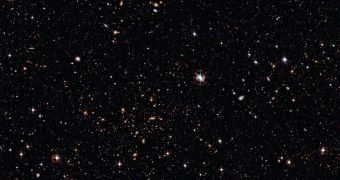Astronomers at the European Southern Observatory (ESO) have just released a new spectacular, wide-field image of a very crowded portion of the sky. The photograph covered several thousands of very distant galaxies, according to the team behind the study, as well as a significant group of such structures that are included in the massive Abell 315 galaxy cluster. But the scientists warn that the visible portion of this particular cluster is only the tip of the iceberg. The entire structure is several times more massive, given that much of its content is made up of dark matter.
This is visible when looking at the shape of the galaxies behind it, which appear to be slightly bent. The ESO team also adds that the most of the stars we see in this new image are almost never visible from Earth with the unaided eye. Most of the bright dots we see in the evening sky are actually stars from our own galaxy, the Milky Way, plus a few extra-bright ones from neighboring galaxies such as Andromeda. Other star “collections” emit very small amounts of visible light, and are therefore too dim to be perceived by the human eye.
One interesting thing to note is that, if we were to become capable of seeing this dim light, the radiation coming from distant galaxies would basically cover the sky. Since we don't have that ability, astronomers rely on devices such as the Wide Field Imager instrument. This is located on the MPG/ESO 2.2-meter telescope facility, which is based at the ESO La Silla Observatory, high in the Chilean Andes. For the new image, scientists used three different filters and long exposure times. The composite photography that resulted from this is of both the wide-field and long-exposure kind. The WFI covered an area of the sky about 34x33 arcminutes across.
“Beginning in the center of the image and extending below and to the left, a concentration of about a hundred yellowish galaxies identifies a massive galaxy cluster, designated with the number 315 in the catalog compiled by the American astronomer George Abell in 1958. The cluster is located between the faint, red and blue galaxies and the Earth, about two billion light-years away from us. It lies in the constellation of Cetus (the Whale),” ESO scientists explain in a press release.
“The presence of dark matter is revealed through its gravitational effect: the enormous mass of a galaxy cluster acts on the light from galaxies behind the cluster like a cosmic magnifying glass, bending the trajectory of the light and thus making the galaxies appear slightly distorted. By observing and analyzing the twisted shapes of these background galaxies, astronomers can infer the total mass of the cluster responsible for the distortion, even when this mass is mostly invisible. However, this effect is usually tiny, and it is necessary to measure it over a huge number of galaxies to obtain significant results,” the astronomers add.

 14 DAY TRIAL //
14 DAY TRIAL //